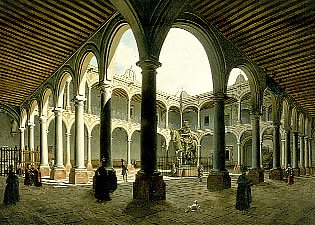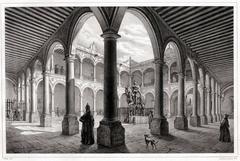
Royal and Pontifical University of Mexico Visiting Hours, Tickets, and Historical Site Guide
Date: 14/06/2025
Introduction
The Royal and Pontifical University of Mexico, established in 1551 by royal decree from King Charles I of Spain, was the first university in North America and the second in the Americas. Modeled after Spain’s leading universities and closely associated with the Catholic Church, it became a central pillar of colonial education and culture in New Spain. Though its original buildings no longer serve educational functions, their historic locations in Mexico City’s Centro Histórico remain significant. Today, visitors can explore these heritage sites, visit related museums and cultural centers, and experience the enduring legacy of Mexico’s academic and cultural evolution—most notably through the National Autonomous University of Mexico (UNAM), its modern successor. This guide provides comprehensive information on the university’s history, current visiting sites and hours, ticketing, accessibility, recommended tours, and nearby attractions, ensuring an enriching visit for history enthusiasts and travelers alike.
For official updates and further background, consult UNAM Official History and Mexico City Tourism - Centro Histórico.
Contents
- Historical Overview
- Colonial Educational and Social Role
- Cultural and Intellectual Legacy
- Institutional Evolution and Modern Impact
- Architectural and Urban Significance
- Visiting the University’s Historic Sites
- Hours and Ticketing
- Accessibility and Travel Tips
- Guided Tours and Events
- Nearby Attractions in Mexico City’s Centro Histórico
- Photography and Virtual Tours
- Frequently Asked Questions (FAQ)
- Conclusion and Visitor Resources
Historical Overview
Founded on September 21, 1551, by King Charles I of Spain, the Royal and Pontifical University of Mexico played a foundational role in shaping the educational and cultural landscape of colonial Mexico. Its first classes began in 1553, offering a curriculum inspired by Spanish institutions such as the University of Salamanca, focusing on theology, canon law, medicine, and the arts. Initially designed for Spanish-born and Creole elites, the university’s influence extended across New Spain’s intellectual and administrative spheres, awarding degrees that shaped the region’s leadership (Wikipedia; Vallarta Daily).
Colonial Educational and Social Role
During the colonial era, the university was the sole degree-granting institution in New Spain. Its primary function was to train clergy, lawyers, and doctors—critical roles in the Spanish colonial administration. The curriculum, taught mainly in Latin, later expanded to include astronomy, native languages, and the arts. Noteworthy scholars, such as Carlos de Sigüenza y Góngora, contributed to its academic prestige (K12 Academics; Education State University).
While the university was a center for learning and debate, access was restricted to the colonial elite, excluding indigenous and mestizo populations (Mexico Historico).
Cultural and Intellectual Legacy
The university was instrumental in spreading Enlightenment ideas, fostering debates that would eventually influence the Mexican independence movement. Its alumni and faculty contributed significantly to the development of Mexican identity and intellectual life (Encyclopedia Britannica - UNAM).
Institutional Evolution and Modern Impact
Following Mexico’s independence, the university underwent several reforms, closures, and transformations. It was dissolved during the liberal reforms of Benito Juárez in 1867, but its faculties and academic traditions persisted. In 1910, Justo Sierra Méndez founded the National Autonomous University of Mexico (UNAM), merging the legacy of the Royal and Pontifical University into a modern public institution. Today, UNAM is Mexico’s largest and most prestigious university, with its Ciudad Universitaria campus designated a UNESCO World Heritage Site (UNESCO World Heritage - Centro Histórico; Britannica).
Architectural and Urban Significance
The original university complex, completed in 1584, was located in the Centro Histórico near República de Guatemala and Licenciado Primo de Verdad streets. Though the main building was demolished in 1910, visitors can still explore related sites such as the UNAM Palace of Autonomy and the Antiguo Colegio de San Ildefonso, which now serve as museums and cultural centers (Mexico City CDMX; San Ildefonso Museum).
Visiting the University’s Historic Sites
Main Locations
- Antiguo Colegio de San Ildefonso: A major cultural center and museum, renowned for its colonial architecture and murals.
- UNAM Palace of Autonomy: Houses exhibitions and educational displays about university autonomy and history.
- Casa de la Primera Imprenta de América: Museum dedicated to the history of printing in the Americas.
- Centuries-old corridors and courtyards: Located throughout the Centro Histórico, reflecting the university’s architectural heritage.
Hours and Ticketing
Antiguo Colegio de San Ildefonso
- Hours: Tuesday to Sunday, 10:00 AM–6:00 PM; closed Mondays and select holidays.
- Tickets: 50–80 MXN ($3–$5 USD); discounts for students, teachers, and seniors.
- Tours: Guided tours included or available for a small fee; English tours may be arranged (San Ildefonso Museum).
UNAM Palace of Autonomy
- Hours: Tuesday to Sunday, 10:00 AM–5:00 PM; closed Mondays and holidays.
- Tickets: Free admission.
- Accessibility: Wheelchair accessible; assistance available (Palacio de la Autonomía).
Casa de la Primera Imprenta de América
- Hours: Similar to other Centro Histórico museums.
- Tickets: Modest admission fee (Casa de la Primera Imprenta).
Accessibility and Travel Tips
- The Centro Histórico is pedestrian-friendly and accessible via Metro (Zócalo or Allende stations), buses, and taxis.
- Wear comfortable shoes due to cobblestones and extensive walking.
- Most major sites are wheelchair accessible, though some historic areas may have limited access.
- The area is generally safe during daylight hours; be vigilant for pickpocketing.
Guided Tours and Special Events
- Walking tours of the Centro Histórico often include the university sites and provide historical context.
- Museums and cultural centers host rotating exhibitions, lectures, and concerts—check official schedules for current offerings.
- Guided tours are available at San Ildefonso and UNAM Palace of Autonomy, with English-language options upon request.
Nearby Attractions in Mexico City’s Centro Histórico
- Metropolitan Cathedral: Mexico’s largest cathedral, adjacent to the Zócalo.
- Templo Mayor: Ancient Aztec ruins and museum.
- Museo Nacional de Arte: Featuring Mexican art from the colonial period to the 20th century.
- Zócalo (Plaza de la Constitución): The historic main square.
Photography and Virtual Tours
- Photography is allowed in most areas, with restrictions on flash and tripods.
- Virtual tours of UNAM’s modern campus and city center sites are available through official portals (UNAM Campus Guide).
- Notable visuals include murals by Diego Rivera, José Clemente Orozco, and David Alfaro Siqueiros, and the courtyards of San Ildefonso.
Frequently Asked Questions (FAQ)
Can I tour the original university buildings?
The original buildings were demolished; however, their historic locations and successor institutions are accessible as museums and cultural centers.
What are the main visiting hours?
San Ildefonso and related sites are generally open Tuesday to Sunday, 10:00 AM–6:00 PM; closed Mondays.
Are guided tours available?
Yes, most sites offer guided tours, with English-language options at major venues.
How much do tickets cost?
Admission ranges from free to approximately 80 MXN ($5 USD); discounts for students and seniors apply.
Is the area accessible for those with disabilities?
Most major sites are wheelchair accessible, though some older sections have limited access.
Conclusion and Visitor Resources
The sites associated with the Royal and Pontifical University of Mexico offer a window into the country’s educational and cultural foundations. Today’s visitor can explore historic architecture, influential murals, and vibrant museums while walking the same streets that once hosted Mexico’s earliest scholars. Be sure to check museum websites for up-to-date hours and event information, and use the Audiala app for audio tours, maps, and the latest cultural news.
Sources and Further Reading
- UNAM Official History
- Encyclopedia Britannica - UNAM
- Mexico City Tourism - Centro Histórico
- UNESCO World Heritage - Centro Histórico
- National Library of Mexico
- UNAM Campus Guide
- Wikipedia - Royal and Pontifical University of Mexico
- Vallarta Daily
- K12 Academics - Education in Mexico
- Education State University - Mexico History
- Mexico Historico - Education and Schools in Colonial Mexico
- Mexico City CDMX - Royal and Pontifical University of Mexico
- San Ildefonso Museum
- Casa de la Primera Imprenta de América
- Palacio de la Autonomía
- Amusing Planet - Murals of National Autonomous University of Mexico
- Official UNAM website
- UNAM United Kingdom portal











































































































































































